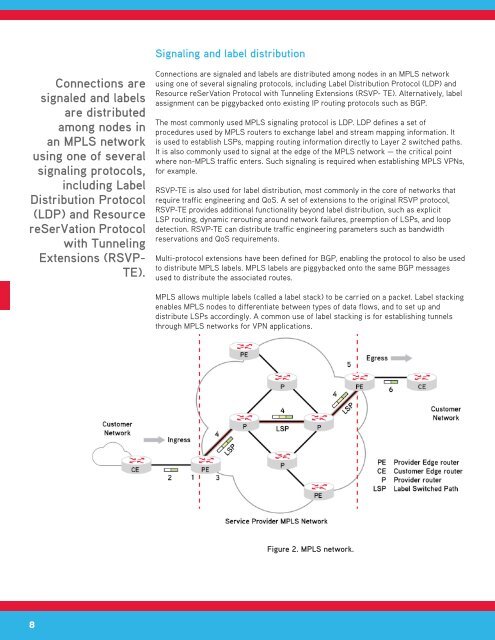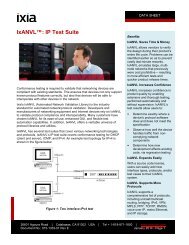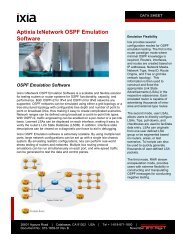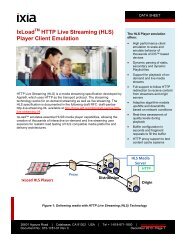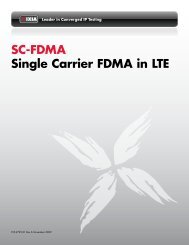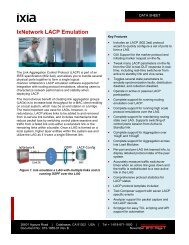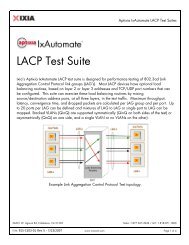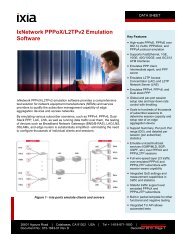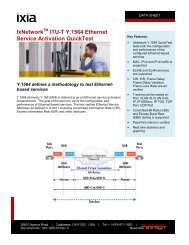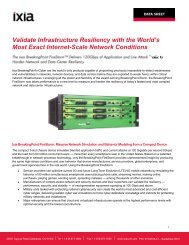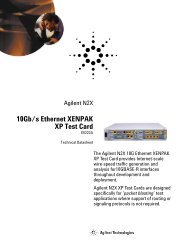Signaling <strong>and</strong> label distributionConnections aresignaled <strong>and</strong> labelsare distributedamong nodes inan <strong>MPLS</strong> networkusing one of severalsignaling protocols,including <strong>Label</strong>Distribution <strong>Protocol</strong>(LDP) <strong>and</strong> ResourcereSerVation <strong>Protocol</strong>with TunnelingExtensions (RSVP-TE).Connections are signaled <strong>and</strong> labels are distributed among nodes in an <strong>MPLS</strong> networkusing one of several signaling protocols, including <strong>Label</strong> Distribution <strong>Protocol</strong> (LDP) <strong>and</strong>Resource reSerVation <strong>Protocol</strong> with Tunneling Extensions (RSVP- TE). Alternatively, labelassignment can be piggybacked onto existing IP routing protocols such as BGP.The most commonly used <strong>MPLS</strong> signaling protocol is LDP. LDP defines a set ofprocedures used by <strong>MPLS</strong> routers to exchange label <strong>and</strong> stream mapping information. Itis used to establish LSPs, mapping routing information directly to Layer 2 switched paths.It is also commonly used to signal at the edge of the <strong>MPLS</strong> network — the critical pointwhere non-<strong>MPLS</strong> traffic enters. Such signaling is required when establishing <strong>MPLS</strong> VPNs,for example.RSVP-TE is also used for label distribution, most commonly in the core of networks thatrequire traffic engineering <strong>and</strong> QoS. A set of extensions to the original RSVP protocol,RSVP-TE provides additional functionality beyond label distribution, such as explicitLSP routing, dynamic rerouting around network failures, preemption of LSPs, <strong>and</strong> loopdetection. RSVP-TE can distribute traffic engineering parameters such as b<strong>and</strong>widthreservations <strong>and</strong> QoS requirements.<strong>Multi</strong>-protocol extensions have been defined for BGP, enabling the protocol to also be usedto distribute <strong>MPLS</strong> labels. <strong>MPLS</strong> labels are piggybacked onto the same BGP messagesused to distribute the associated routes.<strong>MPLS</strong> allows multiple labels (called a label stack) to be carried on a packet. <strong>Label</strong> stackingenables <strong>MPLS</strong> nodes to differentiate between types of data flows, <strong>and</strong> to set up <strong>and</strong>distribute LSPs accordingly. A common use of label stacking is for establishing tunnelsthrough <strong>MPLS</strong> networks for VPN applications.Figure 2. <strong>MPLS</strong> network.8
Data flow in an <strong>MPLS</strong> networkFigure 2 shows a typical <strong>MPLS</strong> network <strong>and</strong> its associated elements. The central cloudrepresents the <strong>MPLS</strong> network itself. All data traffic within this cloud is <strong>MPLS</strong>- labeled.All traffic between the cloud <strong>and</strong> the customer networks is not <strong>MPLS</strong>- labeled (IP forexample). The customer- owned Customer Edge (CE) routers interface with the ProviderEdge (PE) routers (also called <strong>Label</strong> Edge Routers, or LERs) owned by the serviceprovider. At the ingress (incoming) side of the <strong>MPLS</strong> network, PE routers add <strong>MPLS</strong> labelsto packets. At the egress (outgoing) side of the <strong>MPLS</strong> network, the PE routers remove thelabels. Within the <strong>MPLS</strong> cloud, P (Provider) routers (also called <strong>Label</strong> <strong>Switching</strong> Routers,or LSRs), switch traffic hop-by-hop based on the <strong>MPLS</strong> labels.To demonstrate an <strong>MPLS</strong> network in operation, we will follow the flow of data through thenetwork in Figure 2:1. Before traffic is forwarded on the <strong>MPLS</strong> network, the PE routers first establish LSPsthrough the <strong>MPLS</strong> network to remote PE routers.2. Non-<strong>MPLS</strong> traffic (Frame Relay, ATM, Ethernet, etc.) is sent from a customer network,through its CE router, to the ingress PE router operating at the edge of the provider’s<strong>MPLS</strong> network.3. The PE router performs a lookup on information in the packet to associate it with aFEC, then adds the appropriate <strong>MPLS</strong> label(s) to the packet.4. The packet proceeds along its LSP, with each intermediary P router swapping labelsas specified by the information in its LIB to direct the packet to the next hop.5. At the egress PE, the last <strong>MPLS</strong> label is removed <strong>and</strong> the packet is forwarded bytraditional routing mechanisms.6. The packet proceeds to the destination CE <strong>and</strong> into the customer’s network.How Is <strong>MPLS</strong> Used?One of the primary original goals of <strong>MPLS</strong>, boosting the performance of software- basedIP routers, has been superseded as advances in silicon technology have enabled line-raterouting performance implemented in router hardware. In the meantime, additional benefitsof <strong>MPLS</strong> have been realized, notably VPN services <strong>and</strong> traffic engineering.Virtual Private NetworksOne of the primaryoriginal goals of<strong>MPLS</strong>, boostingthe performance ofsoftware- based IProuters, has beensuperseded asadvances in silicontechnology haveenabled line-raterouting performanceimplemented inrouter hardware.A Virtual Private Network (VPN) is a private network service delivered over a public(shared) network. VPNs benefit end customers by allowing remote locations to besecurely connected over a public network, without the expense of buying or leasingdedicated network lines. <strong>MPLS</strong> enables VPNs by providing a circuit-like, connectionorientedframework, allowing carriers to deploy VPNs over the traditionally connectionlessIP network infrastructure.9


